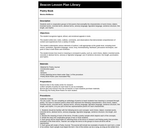
Activities and worksheets on the use and identification of personification.
- Subject:
- English Language Arts
- Material Type:
- Activity/Lab
- Provider:
- Spelling City
- Author:
- Spelling City
- Date Added:
- 02/26/2019

Activities and worksheets on the use and identification of personification.

This is a digital anchor chart.

In this lesson, students study personification in published works of poetry, then create their own.

This resource contains a list of common poetic literary devices with supporting Powerpoint, worksheets and projects.

In this lesson, students work in cooperative groups to find poems that exemplify the characteristics of word choice, dialect, invented words, concrete terms, abstract terms, sensory language, figurative language, sentence structure, line length, and rhythm.

This is a brainstorming activity to gauge the depth and breadth of your student's poetic elements knowledge.You can use this as a pre assessment or formative assessment depending on your instructional needs.The slides can be changed depending on your grade level standards and the literary or poetic elements that you are focusing on in your instruction.

Poets achieve popular acclaim only when they express clear and widely shared emotions with a forceful, distinctive, and memorable voice. But what is meant by voice in poetry, and what qualities have made the voice of Langston Hughes a favorite for so many people?

This course was created by the Rethink Education Content Development Team. This course is aligned to the NC Standards for 7th Grade English Language Arts.

This course was created by the Rethink Education Content Development Team. This course is aligned to the NC Standards for 7th Grade ELA.

In this 3 day lesson plan on The Rhetorical Triangle from PBS Learning Media, students will focus on understanding Aristotle’s three elements of persuasive speech—the ancient Greek words ethos, pathos and logos. Additionally, students will be able to analyze the effectiveness of rhetorical strategies and elements in commercials and speeches.

In this lesson, students explore word choice, paraphrasing, and summarizing by playing a vocabulary game to create riddles and answers.

A young girl, Sarah Stout, despite her father’s request, chooses not to take out the garbage, and soon realizes that there are serious and far-reaching consequences to her choices. In this CCSS lesson, students will explore this story through text dependent questions, academic vocabulary, and writing assignments.

On the first day of seventh grade, Victor and his friend Michael try to hide their insecurities and impress the girls in their class. In turn they learn that teachers can be kind, that girls are approachable, and that taking a risk to fit in can pay off. In this CCSS lesson, students will explore this story through text dependent questions, academic vocabulary, and writing assignments.

Activities and worksheets on the use and identification of similies.

Students will learn about the different types of allusions. This presentation provides students with detailed examples of allusions, and then assigns students to apply learned skills within a self-created poem.

This fantasy takes place on the planet Pern, an imaginary world where dragons help protect the inhabitants from the dangerous Red Star, which rains deadly plant spores every 200 years. These spores can devour every living thing if they land on the planet. In this CCSS lesson, students will explore this story through text dependent questions, academic vocabulary, and writing assignments.

In this lesson, students solve unknown words using context clues, select and generate words for semantic gradients, and develop new semantic gradients and contexts.

In this lesson, students compose Haiku poetry and visually enhance it with writing ink.

In this lesson, students explore how word choice, line length, punctuation, and rhythm contribute to the overall effect of a poem.

Almost every culture has a traditional tale about a character who is granted three wishes. Two are usually used unwisely, and then the third wish is needed to undo one or both of the first two wishes. In this CCSS lesson, students will explore this story through text dependent questions, academic vocabulary, and writing assignments.